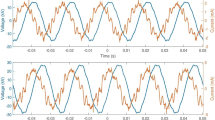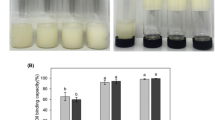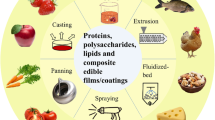Abstract
To explore the potential of winged bean seed protein as a food ingredient, an oil-in water emulsion, [25% (w/w), pH 3] stabilized by the protein (5% solution) was prepared by high-pressure homogenizer and subjected to heat (35–75 °C), cold (4–8 °C) and NaCl (1–4%) conditions alone or in combination, and their physicochemical stability to the treatments was assessed by measuring creaming, droplets characteristics and rheology. Result showed a slight increase in mean droplet size at treatment up to 35 °C and 1–2% NaCl. At treatment of ≥ 55 °C and ≥ 3% NaCl, significant increases in mean droplet size were observed, droplet distribution changed from monomodal to bimodal, advanced flocculation and coalescence up to 75 °C, leading to poly-disperse distribution. No flow was observed until a yield value (σ0) was overcome. At 1% NaCl, the σ was 13 Pa s compared to 21 Pa s at 3–4% NaCl, and above 35 °C treatment, emulsions had high apparent viscosity and exhibited Bingham plastic model resulting from increased droplets sizes.





Similar content being viewed by others
References
B. Wang et al., Ability of flaxseed and soybean protein concentrates to stabilize oil-in-water emulsions. J. Food Eng. 100(3), 417–426 (2010)
O. Benjamin et al., Emulsifying properties of legume proteins compared to β-lactoglobulin and Tween 20 and the volatile release from oil-in-water emulsions. J. Food Sci. 79(10), E2014–E2022 (2014)
J. Ji et al., Preparation and stabilization of emulsions stabilized by mixed sodium caseinate and soy protein isolate. Food Hydrocoll. 51(0), 156–165 (2015)
A. Gharsallaoui et al., Pea (Pisum sativum, L.) protein isolate stabilized emulsions: a novel system for microencapsulation of lipophilic ingredients by spray drying. Food Bioprocess Technol. 5(6), 2211–2221 (2012)
M. Ray, D. Rousseau, Stabilization of oil-in-water emulsions using mixtures of denatured soy whey proteins and soluble soybean polysaccharides. Food Res. Int. 52(1), 298–307 (2013)
K. Demetriades, J.N. Coupland, D.J. McClements, Physicochemical Properties of whey protein-stabilized emulsions as affected by heating and ionic strength. J. Food Sci. 62(3), 462–467 (1997)
C. Bengoechea et al., Temperature and pH as factors influencing droplet size distribution and linear viscoelasticity of O/W emulsions stabilised by soy and gluten proteins. Food Hydrocoll. 24(8), 783–791 (2010)
D. Djordjevic et al., Physical stability of whey protein-stabilized oil-in-water emulsions at pH 3: potential ω-3 fatty acid delivery systems (part A). J. Food Sci. 69(5), C351–C355 (2004)
C. Qian et al., Physical and chemical stability of β-carotene-enriched nanoemulsions: influence of pH, ionic strength, temperature, and emulsifier type. Food Chem. 132(3), 1221–1229 (2012)
D.J. McClements, Protein-stabilized emulsions. Curr. Opin. Colloid Interface Sci. 9(5), 305–313 (2004)
J. German, T. O’Neill, J. Kinsella, Film forming and foaming behavior of food proteins. J. Am. Oil Chem. Soc. 62(9), 1358–1366 (1985)
D. Graham, M. Phillips, Proteins at liquid interfaces. V. Shear properties. J. Colloid Interface Sci. 76(1), 240–250 (1980)
P. Hailing, CRC critical review. Food Sci. Nutr. 155, 13 (1981)
J.E. Kinsella, Functional properties of proteins: possible relationships between structure and function in foams. Food Chem. 7(4), 273–288 (1981)
M. Hu, D.J. McClements, E.A. Decker, Impact of whey protein emulsifiers on the oxidative stability of salmon oil-in-water emulsions. J. Agric. Food Chem. 51(5), 1435–1439 (2003)
M. Hu, D.J. McClements, E.A. Decker, Lipid oxidation in corn oil-in-water emulsions stabilized by casein, whey protein isolate, and soy protein isolate. J. Agric. Food Chem. 51(6), 1696–1700 (2003)
D. Djordjevic, D.J. McClements, E.A. Decker, Oxidative Stability of whey protein-stabilized oil-in-water emulsions at pH 3: potential ω-3 fatty acid delivery systems (part B). J. Food Sci. 69(5), C356–C362 (2004)
S. González-Pérez et al., Emulsion properties of sunflower (Helianthus annuus) proteins. J. Agric. Food Chem. 53(6), 2261–2267 (2005)
D.J. McClements, Food emulsion: principles, practices and techniques, in Contemporary Food Science, 2nd edn. (CRC Group, Boca Raton, 2005), p. 609
F. Liu, C.-H. Tang, Emulsifying properties of soy protein nanoparticles: influence of the protein concentration and/or emulsification process. J. Agric. Food Chem. 62(12), 2644–2654 (2014)
Y. Shao, C.-H. Tang, Characteristics and oxidative stability of soy protein-stabilized oil-in-water emulsions: influence of ionic strength and heat pretreatment. Food Hydrocoll. 37, 149–158 (2014)
M.U. Makeri et al., Comparative analysis of the physico-chemical, thermal, and oxidative properties of winged bean and soybean oils. Int. J. Food Prop. 19(12), 2769–2787 (2016)
N.Q. Ng, Conserving Tropical Leguminous Food Crops, in Conservation of Tropical Plant Species, (Springer, New york, 2013), pp. 213–247
K. Boode, C. Bisperink, P. Walstra, Destabilization of O/W emulsions containing fat crystals by temperature cycling. Colloids Surf. 61, 55–74 (1991)
D. Rousseau, Fat crystals and emulsion stability—a review. Food Res. Int. 33(1), 3–14 (2000)
M.U. Makeri et al., Comparative physico-chemical, functional and structural characteristics of winged bean [Psophocarpus tetragonolobus DC] and Soybean [Glycine max.] Protein isolates. J. Food Meas. Charact. 11(2), 835–846 (2017)
S. Mundi, R.E. Aluko, Physicochemical and functional properties of kidney bean albumin and globulin protein fractions. Food Res. Int. 48(1), 299–306 (2012)
T. Allen, Particle size measuremnet, 4th edn. (Chapman and hall, London, 1992)
E. Keowmaneechai, D. McClements, Effect of CaCl2 and KCl on physiochemical properties of model nutritional beverages based on whey protein stabilized oil-in-water emulsions. J. Food Sci. 67(2), 665–671 (2002)
E. Dickinson, Emulsion gels: the structuring of soft solids with protein-stabilized oil droplets. Food Hydrocoll. 28(1), 224–241 (2012)
H.J. Kim, E.A. Decker, D.J. McClements, Comparison of droplet flocculation in hexadecane oil-in-water emulsions stabilized by β-lactoglobulin at pH 3 and 7. Langmuir 20(14), 5753–5758 (2004)
P. Bellalta et al., Rheological and microstructural characterization of WPI-stabilized O/W emulsions exhibiting time-dependent flow behavior. LWT—Food Sci. Technol. 46(2), 375–381 (2012)
R.J.B.M. Delahaije et al., Protein concentration and protein-exposed hydrophobicity as dominant parameters determining the flocculation of protein-stabilized oil-in-water emulsions. Langmuir 29(37), 11567–11574 (2013)
S. Damodaran, L. Razumovsky, Molecular bases of surface activity of proteins, in Functional Properties of Proteins and Lipids, ed. by F.S.J.R. Whitaker, A.L. Munguia, R.Y. Yada, G. Fuller (American Chemical Society, Washington, DC, 1998), pp. 2–18
A. Kulmyrzaev, H. Schubert, Influence of KCl on the physicochemical properties of whey protein stabilized emulsions. Food Hydrocoll. 18(1), 13–19 (2004)
H. Kim, E. Decker, D. McClements, Impact of protein surface denaturation on droplet flocculation in hexadecane oil-in-water emulsions stabilized by β-lactoglobulin. J. Agric. Food Chem. 50(24), 7131–7137 (2002)
H.-J. Kim, E. Decker, D. McClements, Role of postadsorption conformation changes of β-lactoglobulin on its ability to stabilize oil droplets against flocculation during heating at neutral pH. Langmuir 18(20), 7577–7583 (2002)
D.G. Dalgleish, Food emulsions—their structures and structure-forming properties. Food Hydrocoll. 20(4), 415–422 (2006)
M. Corredig, D.G. Dalgleish, A differential microcalorimetric study of whey proteins and their behaviour in oil-in-water emulsions. Colloids Surf. B 4(6), 411–422 (1995)
E. Davies, E. Dickinson, R. Bee, Shear stability of sodium caseinate emulsions containing monoglyceride and triglyceride crystals. Food Hydrocoll. 14(2), 145–153 (2000)
H.A. Barnes, Rheology of emulsions—a review. Colloids Surf. A 91, 89–95 (1994)
C.-H. Tang, F. Liu, Cold, gel-like soy protein emulsions by microfluidization: emulsion characteristics, rheological and microstructural properties, and gelling mechanism. Food Hydrocoll. 30(1), 61–72 (2013)
Acknowledgements
The first author, Makeri, U. M. thank the Malaysian Government for awards of a Ph.D. Scholarship through the Malaysian International Scholarship (MIS) and the study fellowship by the Ahmadu Bello University Zaria. The research was funded by the Universiti Putra Malaysia.
Author information
Authors and Affiliations
Corresponding authors
Ethics declarations
Conflict of interest
The authors declared they have no conflict of interest in any form.
Rights and permissions
About this article
Cite this article
Makeri, M., Muhammad, K., Ghazali, H. et al. Influence of temperature and ionic conditions on the rheology and droplets characteristics of winged bean protein stabilized oil-in-water emulsion. Food Measure 13, 97–106 (2019). https://doi.org/10.1007/s11694-018-9922-1
Received:
Accepted:
Published:
Issue Date:
DOI: https://doi.org/10.1007/s11694-018-9922-1




